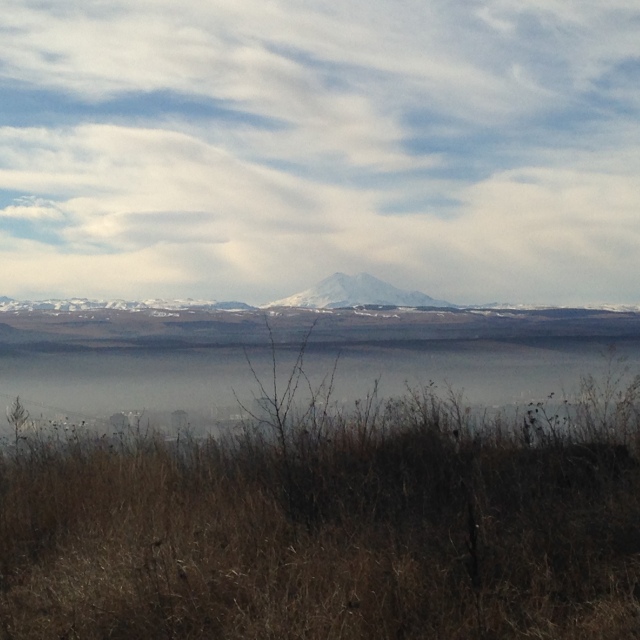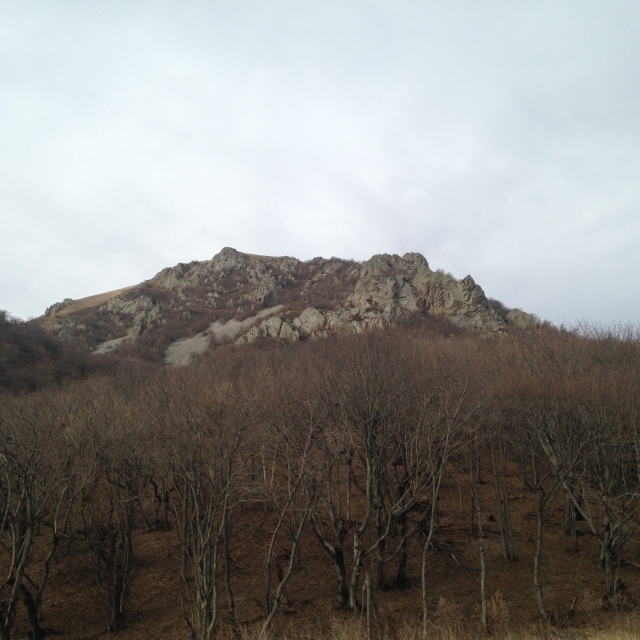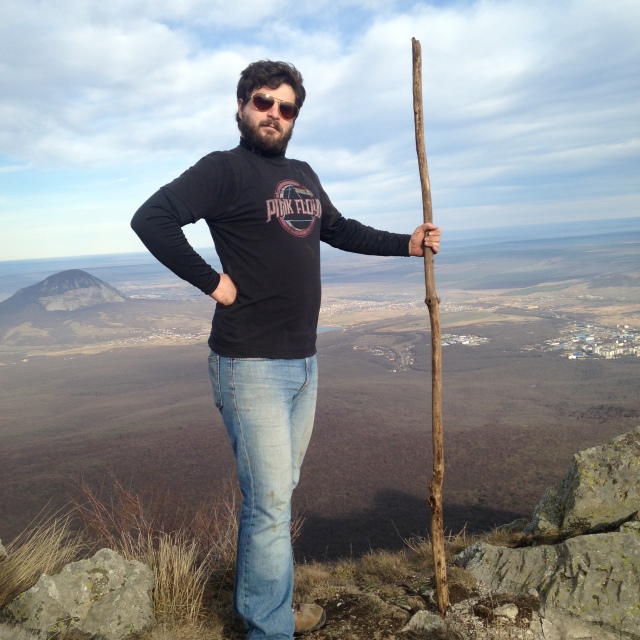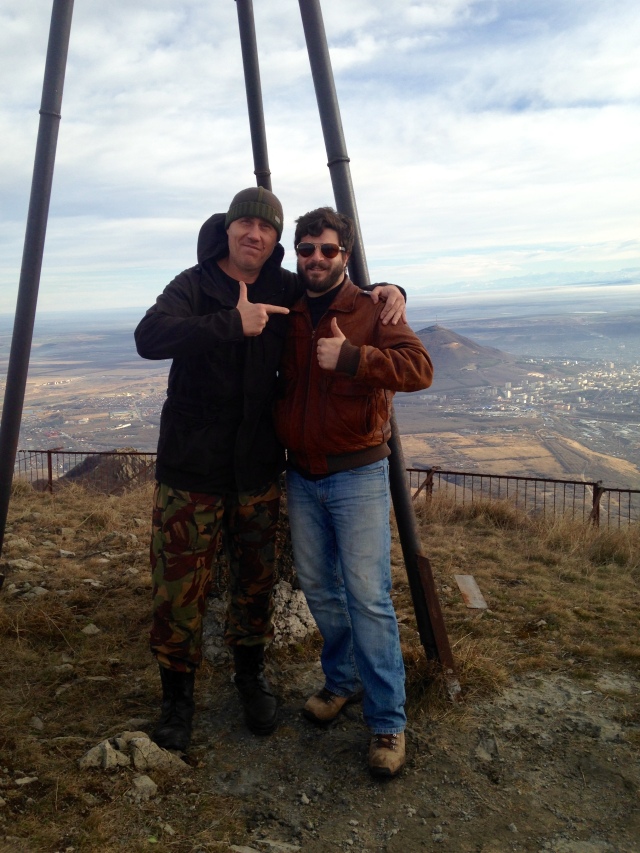On the 15th we had our first snow fall of the year. I was walking back to the obshaga after an evening of watching “Downtown Abby” with Alina and Vika when the fuzzy, little snowflakes starting falling from the heavens. It wasn’t cold enough for the snow to stick to the ground, melting into pools of water upon contact, but at the higher elevations it was a sight to see. In the morning I got up and went to the kitchen window and scanned the horizon. The Caucasus look beautiful. They are all covered in snow, another good layer on top of their peaks, the snow glistening in the sun light. The lighting gave the mountains a navy blue hue, their sharp peaks cutting the sky like an eagles talons. The Caucasus look so primeval compared to the Rockies. The shapes are both angular, but also organic. It is amazing what over a 100 millions years of volcanic activity can do and form, the rock morphing into shapes that only lava and a million years of wind and water erosion can accomplish. I like to think of mountains as passive overseers or wardens. They hold within them ancient memories and will age only an instant within a thousand human life times. This makes looking at them even more fun, because as I stand on a hill or on top of a smaller mountain such as Malshuk, and I look at the Greater Caucasus region and of course at Elbrus with his duel peaks; I know that thousand years ago, hundreds of people stood here and looked at the same sight that I’m seeing. A great “human moment.” The air is crisp and cold, reminders that winter is on it’s way. Some of the trees on the mountain side and in the city center, still refuse to give up their leaves, a testament to the defiant nature that the Caucasus embodies in both the terrain and the peoples who call this region home. As the Georgians say, the Caucasus has the “energetikis t’avisup’lebis” or the “energy of freedom.” You sense it in the “rynki” (or markets, another Russian word that I prefer to use over the English equivalent) when seeing the free market at work. I sense it in the movements and gestures when the local cultures dance lezginka. You sense it in the air when the mountains whisper to you the myths and legends that are carved into their stoney skin. You feel it when a Russian recites poetry from Lermontov or Pushkin from memory. It is ironic to think that over two hundred years ago, the Caucasus was viewed as a prison and like in Siberia, people where exiled to this place to live the rest of their lives, such was the power of the Russian Tsars.
The link above is of the National Georgian Dance Team, preforming various styles of ballet and Georgian lezginka. Enjoy.
Living in Nebraska for the last 17 plus years has taught me that change is a constant and that the weather is unpredictable. For those of you reading in the States and elsewhere, if you are familiar with prairie or mountain life, you too understand this. The last three days have felt like Nebraska in regards to the weather patterns, or lack thereof. It is so windy now, the clouds moving in rapidly over the steppes and hugging the summits of Malshuk and Beshtau. They are gray in color and it seems that we will be in for some rain later. It is very clear and sunny out during the mornings so at least the happy, warm rays of the sun can be enjoyed for a little while. In Russian, the words for “windy” and “wind” are “vetreno” and “veter.” They are very relevant now, hopeful I will remember to use these words when they come up in conversation. I do enjoy the range of biomes here in the Caucasus. Staring on the Black Sea coast, black pebbled beaches are pounded by the strong waves. In the Northwestern half of the Caucasus range, there are lush, alpine and deciduous forests. Glaciers coat the peaks of the mountains, Dombai being a stellar example. As one heads northward, the forests give way to grasslands, which in the spring and summer, present lovely yellow flowers. Journeying eastward, the grasslands turn into rocky gorges, with rivers that ever so slowly, cut into the earth. These canyons become the hallmarks of Kabardino-Balkaria and North Ossetia. Elbrus then stands tall and proud, an icon of the area. Farther to the east the canyons turn into high plains desert, getting dryer and dryer. Ingushetia and Chechnya, become arid and give way to the Nogay Steppe. In Dagestan’s southern borders, great sand dunes litter the landscape all the way to the coast of the Caspian Sea. In a few months, the Caucasus will be covered in snow and I’m eagerly awaiting winter. As the Georgian legends tell, the Caucasus (in particular, the historic homelands of the Georgians), are so beautiful that at the beginning of creation, God reserved these lands from himself, but after experiencing Caucasian hospitality, he honored them by giving his hosts these lands instead. One of the better origin stories that I’ve heard from the Caucasus.
Things have been pretty mellow since my last trip outside of Pyatigorsk. It is funny because for me the weeks seem to go by fast when I have a trip planned, but when I don’t go somewhere, the week goes by very slowly. Maybe its because when I travel somewhere, I have something to look forward to. I’m fiddling with an idea about planning a trip across the border and to see more of Georgia with my friends here in the dorm. The problem will be timing the trip. I’m thinking it will be better to go during the April and May, when the weather is warmer and the mountains still have snow on them. The first time I went to Georgia, it was just for a few days on business with the U.S. Embassy in Tbilisi. I never really got to explore or experience Tbilisi so, the plan would be to send a few days there and to then head east to see the vineyards and monasteries of Sighnaghi and Velistsikhe. I’m know a good amount about what I what to do and see and I look forward to writing about it if this plan works out. To prepare for the trip, I’ve started “Georgian 101” on my own. I’ve written out the Georgian alphabet in my notebook, all thirty-three characters and their phonetic sounds. There are a lot of consonants. Georgian is another native language to the Caucasus region and has one of the oldest original alphabets in the world, the first Georgian script dating to the 3rd century B.C. The script is called “mkhedruli.” As an example: “ქართული,” “kartuli” or in English the word for “Georgian.” I love how the letters loop, the calligraphy is fantastic. I’m hoping to start learn either Georgian or Azeri next semester so I can get a Caucasian language under my belt. I’d love to learn Kabardian as well, but this maybe too ambitious, with a fifty-three letter alphabet, with limited vowels. I’m writing this down so I can release my excitement. Just the thought of going to Georgia on a trip is very appealing to me. If had to choose my favorite culture in the Caucasus, it would that of the Georgians (as much as I love the Kabardian and larger Adige or Circassian culture). They are an ancient people, with so much to offer in regards to cuisine, music, and dance (their style of lezginka is amazing to watch).
I had a good teaching moment this week. Connie teaches around five classes a week and on Tuesday she was conducting a lesson on the educational systems in the United Kingdom, in the United States and in Russia. She had asked me if I was willing to come by as a guest and talk with her class about the educational system in the U.S. I mainly discussed about publics schools (I used the model from the Papillion and Bellevue School Districts, as public schools will different from State to State) and private universities such as Hastings. The students seemed to be surprised at the costs and intrigued by the ability to choose both the college, the classes, and the major that one can take. University systems in the UK seemed strange to me after Connie discussed the lay out at Oxford, as it seemed more specialized. I value the concept of the liberal arts education system as I think being well rounded in other subjects besides ones major is very useful. I also think being able to discuss with professors and peers one on one during classes is very beneficial, as college teaches you how to think more critically. The British system seems to be a good way for people who know that they want to do at an early age (around 16-18). I’d honestly have to have a longer conversation about both the systems to pick through all the pros and cons. Needless to say, conversation is a great way to learn and hearing from personal experience is also key, sometimes better and more informative in some cases.
The the 22nd, I had an opportunity to climb Mount Beshtau again. I met up with a friend of mine, an Ossetian man, who is an alpinist of sorts. He has experience climbing several mountains in the region, including Beshtau. Besthtau is 1402 meters (or 4,599 feet). This mountain is has been the inspiration of legends and poems in the region, form the local mythology to the writings of Lermontov. Lermontov describes Beshtau and his five peaks (for which Pyatigorsk is named after, literally the “five mountains”), within his novel “A Hero of Out Time,” as “looming blue,” like “the last thundercloud of a tempest dispersed.” His description is not far off. The weather was prefect for our hike. The air was chilly, but the sun was warm. It is truly amazing when living at high attitudes. Elbrus was so clear, you could see the winkles and folds of the snow as it clashed against the rocks. The whole of the Greater Caucasus range was visible. The sharp edges of their peaks looked like the teeth of a saw, cutting into the sky. They were covered in snow, like white crystals from a chandelier. The sun was bright and marvelous, shadows cast onto the ground by the few clouds which whisped around. I was stunned by the perfection of the weather and view. He went from the obshaga by foot, walking northwest toward Beshtau.

As we walked, the streets where busy with activity. Shashlik was being cooked for the mid-morning meals. The smell of cooked meat was wonderful. People were all over the the place. There is an automobile “market” on the outskirts of town. People buy and sell used and new cars here, automobiles lined up on the dirt road. We headed up the road toward Beshtau. Once you get out of Pyatigorsk and onto the country roads, it becomes quiet. This silence is a wonderful thing to experience, and it reminded me a lot about home, during the many Scouting campouts and trips. On occasion we would see a car drive by, a person walk down from Beshtau, and a pheasant or two fly away in a panic when hearing our heavy boots hit the road as we walked. I took a lot of great photos when on the road, to capture a few amazing imagines of the mountains. The brushes still have a few berries on them and we ate some on the way up. Wild blueberries taste fantastic. Climbing Beshtau must be done in stages. The first stage is getting through the birch forest. The terrain is very steep and the woodland is very dense. Thick piles of leaves cracked and crunched from under our feet as we walked. Walking up this first stage was difficult for me as I’m not used to the lower oxygen content. I was breathing very heavily and my heart was pounding in my chest. We got a quarter of the way up and I took several more photos. The hardest time of the trek up was getting through the second stage, or the middle level of the mountain. It had snowed a week earlier and Beshtau was covered in snow. Now the majority of the snow had melted and it made the accessible paths to the summit a muddy mess. This of course made our journey very dangerous. I slipped several times and if I hadn’t had a root, tree branch or rock to grab, I would have surly fell and hit head my head or broke my leg on one of the many rocks at the base. On this difficult part of our trip, we found a strong stick, about a meter and a half in length. It was a much needed tool, as it saved me from slipping many times and helped me climb the steepest parts.


With my newly claimed staff, I felt like I could conquer anything. It helped me during the trip, both up and down the mountain. I was reminded about how difficult doing the things “worth” doing are. If it was easy, there would be no point to doing it. Earning something, by bleeding, sweeting and working for it is the true reward. Climbing and struggling in the mud, reminded me of our ancestors and of the people who lived here in this region hundreds of years ago. Clawing out a living, battling the elements. There is a Russian proverb, that says, “Why climb the mountain, when you can go around it?” This maybe the less painful and easiest way, but I prefer the Kabardian proverb, “One is only as strong was the summit he climbs.” Again, earn it. We, as human being are meant to overcome challenges and if we take the easy route, we don’t learn or change. Yes, I was in pain, yes I was coved in mud, my finger nails and hands were filthy (and for those of you who know me well, you can imagine how that must have made me feel), and yes, I was sweeting buckets, but that was apart of the experience. With my staff in hand, I felt like Moses, climbing Mount Sinai. It was a good feeling. We climbed on the side of the summit that was arguably the most difficult, regardless of the melted snow. The side we climbed had to be at some points at least 75 degrees. It was very difficult, sweet ran down my forehead. At the end of the hike, it all had dried to white crystals around my hairline. I was so glad to have brought two liters of water with me. After this hard level, we then got to the third and final step in our long trip on the mountain. The third level, starts at the point where tree line ends. The peak is covered in sharp rocks, long brown grasses, and thorn brushes. We walked up to the summit ever so slowly as I was running on empty. At the top of Beshtau, there is a security station that has radio equipment, medicinal supplies and really chill security guards. I met a guard by the name of Misha who was very kind and thought it was cool that an American was visiting for a second time (yes, he remembered me from my first visit two years ago). He invited us for tea in that little shack on the mountain and we talked about the security business in our respective countries. I had a very good time and it was great to chat and get warm again. Tea will do wonders for your health. One may think that England is the tea drinking place, but the Russians have more tea drinking customs and institutions. Only black tea traditionally speaking, none of the green tea “stuff.”


Top of the summit was gorgeous. The view was so clear and the lighting was prefect, as the shadow and mountains gave off a blue hue and misty clouds were forming over some of the lower areas. The sun was setting at around 4:45 in the afternoon and yellow and orange color started to peek over the Greater Caucasus range. Elbrus looked so pretty and the other mountains showed off there stunning appearances. Malshuk was covered with clouds, a beautiful, white dress to fit her lovely figure. Lermontov described Malshuk as “raising like a shaggy Persian fur cap.” I hold the old girl at higher stands, as she’s still in her prime and more beautiful then a “Persian fur cap,” but writers will be writers. Mount Zmeyka (3,261 ft.) was very pretty too, a watchful guardian over the city of Mineralnya Vody. To the Southwest, looking down the slopes of Beshtau, the smaller mountains of Shelvdivaya, Kabanka and Medovaya, looked cute, their little peaks just touching the incoming mist/clouds which were floating above the steppe. In the distance, Dzhutsa and Yutsa stood proudly like sentinels looking over the Etoka Valley or in the Adyghe language, “Mud Valley.” When I travel in the Caucasus sometimes feel like Pechorin (one of the main characters in Lermontov’s, “A Hero of Our Time), or like the Caucasian dzhigit (a kind of Caucasian bard, who tells stories in great detail and is a skilled horsemen, doing tricks and performing stunts). I’ve been called a dzhigit by Elberd’s mother during the first time I wore a cherkeska (the traditional regalia of many Caucasus peoples) and also by a Chechen women who’s children attend English Club. I took another round of photos when on the summit and we headed down on of paths to return home. The photos from this trip are the best I’ve taken of the Greater Caucasus Range as of yet. It was so exciting.

A very good end to a long week. This Sunday has literally been a “day of rest.” All that walking up and down has done me in. Cheers to you all. Целую и пока.






























